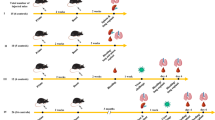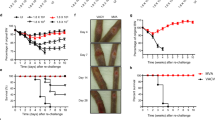Abstract
Sendai virus (SeV) is able to transfect airway epithelial cells efficiently in vivo. However, as with other viral vectors, repeated administration leads to reduced gene expression. We have investigated the impact of inducing immunological tolerance to immunodominant T-cell epitopes on gene expression following repeated administration. Immunodominant CD4 and CD8 T-cell peptide epitopes of SeV were administered to C57BL/6 mice intranasally 10 days before the first virus administration with transmission-incompetent F-protein-deleted ΔF/SeV-GFP. At 21 days after the first virus administration, mice were again transfected with ΔF/SeV. To avoid interference of anti-GFP antibodies, the second transfection was carried out with ΔF/SeV-lacZ. At 2 days after the final transfection lung β-galactosidase expression, T-cell proliferation and antibody responses were measured. A state of ‘split tolerance’ was achieved with reduced T-cell proliferation, but no impact on antiviral antibody production. There was no enhancement of expression on repeat administration; instead, T-cell tolerance was, paradoxically, associated with a more profound extinction of viral expression. Multiple immune mechanisms operate to eradicate viruses from the lung, and these findings indicate that impeding the adaptive T-cell response to the immunodominant viral epitope is not sufficient to prevent the process.
This is a preview of subscription content, access via your institution
Access options
Subscribe to this journal
Receive 12 print issues and online access
$259.00 per year
only $21.58 per issue
Buy this article
- Purchase on Springer Link
- Instant access to full article PDF
Prices may be subject to local taxes which are calculated during checkout





Similar content being viewed by others
References
Brennan AL, Geddes DM . Bringing new treatment to the bedside in cystic fibrosis. Pediatr Pulmonol 2004; 37: 87–98.
Kreda SM, Mall M, Mengos A, Rochelle L, Yankaskas J, Riordan JR et al. Characterization of wild-type and deltaF508 cystic fibrosis transmembrane regulator in human respiratory epithelia. Mol Biol Cell 2005; 16: 2154–2167.
Kitson C, Angel B, Judd D, Rothery S, Severs NJ, Dewar A et al. The extra- and intracellular barriers to lipid and adenovirus-mediated pulmonary gene transfer in native sheep airway epithelium. Gene Therapy 1999; 6: 534–546.
Yonemitsu Y, Kitson C, Ferrari S, Farley R, Griesenbach U, Judd D et al. Efficient gene transfer to airway epithelium using recombinant Sendai virus. Nat Biotechnol 2000; 18: 970–973.
Griesenbach U, Cassady R, Ferrari S, Fukumura M, Müller C, Schmitt E et al. The nasal epithelium as a factory for systemic protein delivery. Mol Ther 2002; 5: 98–103.
Ferrari S, Farley R, Munkonge F, Griesenbach U, Smith SN, You J et al. Recombinant Sendai virus-mediated CFTR cDNA transfer. Mol Ther 2003; 7: S38 (abstr. 94).
Ferrari S, Griesenbach U, Shiraki-Iida T, Shu T, Hironaka T, Hou X et al. A defective nontransmissible recombinant Sendai virus mediates efficient gene transfer to airway epithelium in vivo. Gene Therapy 2004; 11: 1659–1664.
Boyton RJ, Openshaw PJ . Pulmonary defences to acute respiratory infection. Br Med Bull 2002; 61: 1–12.
Kolb M, Inman M, Margetts PJ, Galt G . Budesonide enhances repeated gene transfer and expression in the lung with adenoviral vectors. Am J Respir Crit Care Med 2001; 164: 866–872.
Yang Y, Trinchieri G, Wilson JM . Recombinant IL-12 prevents formation of blocking IgA antibodies to recombinant adenovirus and allows repeated gene therapy to mouse lung. Nat Med 1995; 1: 890–893.
Chirmule N, Truneh A, Haecker SE, Tazelaar J, Gao G, Raper SE et al. Repeated administration of adenoviral vectors in lungs of human CD4 transgenic mice treated with a nondepleting CD4 antibody. J Immunol 1999; 163: 448–455.
Ferrari S, Griesenbach U, Geddes DM, Alton E . Immunological hurdles to lung gene therapy. Clin Exp Immunol 2003; 132: 1–8.
Beck SE, Jones LA, Chesnut K, Walsh SM, Reynolds TC, Carter BJ et al. Repeated delivery of adeno-associated virus vectors to the rabbit airway. J Virol 1999; 73: 9446–9455.
Halbert CL, Rutledge EA, Allen JM, Russell DW, Miller AD . Repeat transduction in the mouse lung by using adeno-associated virus vectors with different serotypes. J Virol 2000; 74: 1524–1532.
Manning WC, Zhou S, Bland MP, Escobedo JA, Dwarki V . Transient immunosuppression allows transgene expression following readministration of adeno-associated viral vectors. Hum Gene Ther 1998; 9: 477–485.
Halbert CL, Standaert TA, Wilson CB, Miller AD . Successful readministration of adeno-associated virus vectors to the mouse lung requires transient immunosuppression during the initial exposure. J Virol 1998; 72: 9795–9805.
Auricchio A, O'Connor E, Weiner D, Gao G, Hildinger M, Wang L et al. Noninvasive gene transfer to the lung for systemic delivery of therapeutic proteins. J Clin Invest 2002; 110: 499–504.
Kalb TH, Chuang MT, Marom Z, Mayer L . Evidence for accessory cell function by class II MHC antigen-expressing airway epithelial cells. Am J Respir Cell Mol Biol 1991; 4: 320–329.
Kurosawa S, Myers AC, Chen L, Wang S, Ni J, Plitt JR et al. Expression of the costimulatory molecule B7-H2 (inducible costimulator ligand) by human airway epithelial cells. Am J Respir Cell Mol Biol 2003; 28: 563–573.
Mitchison NA . The dosage requirements for immunological paralysis by soluble proteins. Immunology 1968; 15: 509–530.
Weiner HL, Friedman A, Miller A, Khoury SJ, Al-Sabbagh A, Santos L et al. Oral tolerance: immunologic mechanisms and treatment of animal and human organ-specific autoimmune diseases by oral administration of autoantigens. Annu Rev Immunol 1994; 12: 809–837.
Daniel D, Wegmann DR . Protection of nonobese diabetic mice from diabetes by intranasal or subcutaneous administration of insulin peptide B-(9–23). Proc Natl Acad Sci USA 1996; 93: 956–960.
Chai JG, James E, Dewchand H, Simpson E, Scott D . Transplantation tolerance induced by intranasal administration of HY peptides. Blood 2004; 103: 3951–3959.
Tsitoura DC, DeKruyff RH, Lamb JR, Umetsu DT . Intranasal exposure to protein antigen induces immunological tolerance mediated by functionally disabled CD4+ T cells. J Immunol 1999; 163: 2592–2600.
Haselden BM, Kay AB, Larche M . Immunoglobulin E-independent major histocompatibility complex-restricted T cell peptide epitope-induced late asthmatic reactions. J Exp Med 1999; 189: 1885–1894.
Oldfield WL, Larche M, Kay AB . Effect of T-cell peptides derived from Fel d 1 on allergic reactions and cytokine production in patients sensitive to cats: a randomised controlled trial. Lancet 2002; 360: 47–53.
Altmann DM, Blyth WA . Protection from herpes simplex virus-induced neuropathology in mice showing delayed hypersensitivity tolerance. J Gen Virol 1985; 66: 1297–1303.
Karpus WJ, Pope JG, Peterson JD, Dal Canto MC, Miller SD . Inhibition of Theiler's virus-mediated demyelination by peripheral immune tolerance induction. J Immunol 1995; 155: 947–957.
DeMatteo RP, Chu G, Ahn M, Chang E, Barker CF, Markman JF . Long-lasting adenovirus transgene expression in mice through neonatal intrathymic tolerance induction without the use of immunosuppression. J Virol 1997; 71: 5330–5335.
Cole GA, Hogg TL, Woodland DL . T cell recognition of the immunodominant Sendai virus NP324–332/Kb epitope is focused on the center of the peptide. J Immunol 1995; 155: 2841–2848.
Zhong W, Marshall D, Coleclough C, Woodland DL . CD4+ T cell priming accelerates the clearance of Sendai virus in mice, but has a negative effect on CD8+ T cell memory. J Immunol 2002; 164: 3274–3282.
Cauley LS, Cookenham T, Miller TB, Adams PS, Vignali KM, Vignali DAA et al. Cutting edge: virus-specific CD4+ memory T cells in nonlymphoid tissues express a highly activated phenotype. J Immunol 2002; 169: 6655–6658.
Cole GA, Hogg TL, Woodland DL . The MHC class I-restricted T cell response to Sendai virus infection in C57BL/6 mice: a single immunodominant epitope elicits an extremely diverse repertoire of T cells. Int Immunol 1994; 6: 1767–1775.
Mastrangeli A, Harvey B-G, Yao J, Wolff G, Kovesdi I, Crystal RG et al. ‘Sero-switch’ adenovirus-mediated in vivo gene transfer: circumvention of anti-adenovirus humoral immune defenses against repeat adenovirus vector administration by changing the adenovirus serotype. Hum Gene Ther 1996; 7: 79–87.
Sakai Y, Kiyotani K, Fukumura M, Asakawa M, Kato A, Shioda T et al. Accommodation of foreign genes into the Sendai virus genome: sizes of inserted genes and viral replication. FEBS Lett 1999; 456: 221–226.
Li Ho, Zhu YF, Asakawa M, Kuma H, Hirata T, Ueda Y et al. A cytoplasmic RNA vector derived from nontransmissible Sendai virus with efficient gene transfer and expression. J Virol 2002; 74: 6564–6569.
Inoue M, Tokusumi Y, Ban H, Shirakura M, Kanaya T, Yoshizaki M et al. Recombinant Sendai virus vectors deleted in both the matrix and the fusion genes: efficient gene transfer with preferable properties. J Gene Med 2004; 6: 1069–1081.
St George JA . Gene therapy progress and prospects: adenoviral vectors. Gene Therapy 2003; 10: 1135–1141.
Sarukhan A, Camugli S, Gjata B, von Boehmer H, Danos O, Jooss K . Successful interference with cellular immune responses to immunogenic proteins encoded by recombinant viral vectors. J Virol 2001; 75: 269–277.
Dubois PM, Pihlgren M, Tomkowiak M, Van Mechelen M, Marvel J . Tolerant CD8 T cells induced by multiple injections of peptide antigen show impaired TCR signaling and altered proliferative responses in vitro and in vivo. J Immunol 1998; 161: 5260–5267.
Gotsman I, Alper R, Klein A, Rabbani E, Engelhardt D, Ilan Y . Inducing oral immune regulation of hepatitis B virus envelope proteins suppresses the growth of hepatocellular carcinoma in mice. Cancer 2002; 94: 406–414.
Fields PA, Armstrong E, Hagstrom JN, Arruda VR, Murphy ML, Farrell JP et al. Intravenous administration of an E1/E3-deleted adenoviral vector induces tolerance to factor IX in C57BL/6 mice. Gene Therapy 2001; 8: 354–361.
Raz I, Elias D, Avron A, Tamir M, Metzger M, Cohen IR . Beta-cell function in new-onset type 1 diabetes and immunomodulation with a heat-shock protein peptide (DiaPep277): a randomised, double-blind, phase II trial. Lancet 2001; 358: 1749–1753.
Yewdell JW, Bennink JR . Immunodominance in major histocompatibility complex class I-restricted T lymphocyte responses. Annu Rev Immunol 1999; 17: 51–88.
Hogan RJ, Zhong W, Usherwood EJ, Cookenham T, Roberts AD, Woodland DL . Protection from respiratory virus infections can be mediated by antigen-specific CD4(+) T cells that persist in the lungs. J Exp Med 2001; 193: 981–986.
Zhong W, Roberts AD, Woodland DL . Antibody-independent antiviral function of memory CD4+ T cells in vivo requires regulatory signals from CD8+ effector T cells. J Immunol 2001; 167: 1379–1386.
Hoyne GF, Dallman MJ, Lamb JR . Linked suppression in peripheral T cell tolerance to the house dust mite derived allergen Der p 1. Int Arch Allergy Immunol 1999; 118: 122–124.
Nash AA, Ashford NP . Split T-cell tolerance in herpes simplex virus-infected mice and its implication for anti-viral immunity. Immunology 1982; 45: 761–767.
Hussell T, Openshaw PJ . IL-12-activated NK cells reduce lung eosinophilia to the attachment protein of respiratory syncytial virus but do not enhance the severity of illness in CD8 T cell-immunodeficient conditions. J Immunol 2000; 165: 7109–7115.
Scaria A, Sullivan JA, St George JA, Kaplan JM, Lukason MJ, Morris JE et al. Adenoviral vector expressing ICP47 inhibits adenovirus-specific cytotoxic T lymphocytes in nonhuman primates. Mol Ther 2000; 2: 505–514.
Acknowledgements
This work was supported by a Cystic Fibrosis Trust Senior Research Fellowship (UG) and a Medical Research Council Clinician Scientist Fellowship (RJB) and the Cystic Fibrosis Trust.
Author information
Authors and Affiliations
Corresponding author
Rights and permissions
About this article
Cite this article
Griesenbach, U., Boyton, R., Somerton, L. et al. Effect of tolerance induction to immunodominant T-cell epitopes of Sendai virus on gene expression following repeat administration to lung. Gene Ther 13, 449–456 (2006). https://doi.org/10.1038/sj.gt.3302677
Received:
Revised:
Accepted:
Published:
Issue Date:
DOI: https://doi.org/10.1038/sj.gt.3302677
Keywords
This article is cited by
-
Validation of recombinant Sendai virus in a non-natural host model
Gene Therapy (2011)
-
Pushing the envelope in the lung
Gene Therapy (2011)
-
Bactofection of lung epithelial cells in vitro and in vivo using a genetically modified Escherichia coli
Gene Therapy (2008)
-
Gene therapy progress and prospects: cystic fibrosis
Gene Therapy (2006)



